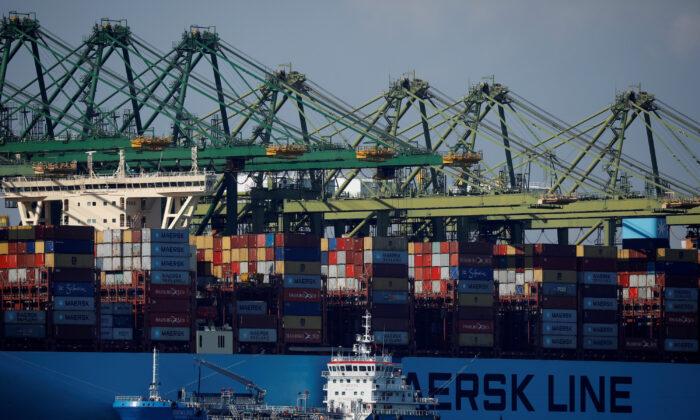LONDON/LOS ANGELES—China’s fast-spreading coronavirus is throwing the global container shipping trade out of sync, with lines re-routing cargos and reducing calls to Chinese ports, setting the scene for months of delivery delays ahead, industry sources said.
The spread of the deadly virus has shut down cities and factories in China and disrupted global air travel.
China’s decision to extend its Lunar New Year holiday period until Feb. 10 has compounded logistical complications, despite its ports staying open. China is a vital link to the container sector, transporting everything from fresh food to phones and designer clothes as well as industrial parts.
The world’s top container lines Maersk, MSC, and CMA CGM have all reduced calls to China, known as blank sailings, the companies said in recent days.
Exports of goods from China have already been hit, with broader repercussions. Hyundai Motor has said it will suspend production in South Korea, its biggest manufacturing base, because of a lack of spare parts.
Disruptions to sea cargo flows have compounded an already pressured situation for shipping lines as they struggle with weaker markets and higher costs from new International Maritime Organization (IMO) regulations on low sulfur fuel.
Shipping and trade sources say regular schedules are also being affected by truck and port workers in China stuck at home or away from their places of work. In addition, warehouses around dock areas in China are not fully working. This has led to ships being diverted from China to ports in South Korea.
South Korea’s Busan port, one of the world’s major container terminals, has already seen a spillover with container capacity at 78 percent and could rise further from its usual level of 70 percent, a Busan port official said.
“Shippers are parking cargo at our ports, so later, perhaps when the coronavirus dies down and the level of cargo (backlogged in China ports) decreases, they can deploy a small ship to carry these cargo to their destination in Chinese ports,” the official said.
More Delays Ahead
While China’s Lunar New Year period usually leads to a slowdown, the virus is expected to further reduce cargo volumes.Lasse Kristoffersen, chief executive of Norwegian shipping group Torvald Klaveness, told Reuters that 25 percent of its container fleet was affected as sailings were canceled.
“This is largely due to lower volumes on China. This is normal during Lunar New Year, but it seems to us that the volumes are lower than normal for this period—likely impacted by the coronavirus,” he told Reuters.
U.S.-based shipping industry consultant Jon Monroe, whose company is active in China, said that blank sailings in February were higher than usual. Even when the impact of the virus dies down there will be a rush to ship goods in and out of China, creating more logistical problems.
“Everybody will be making up for lost time. This is really the perfect storm,” he said.
Shipping consultancy Alphaliner said extended holidays and emergency measures to tackle the virus were estimated to reduce cargo volumes at Chinese ports including Hong Kong by over 6 million TEUs (20 foot equivalent units) in the first quarter of 2020 and forecast global container throughput growth would fall by at least 0.7 percent in 2020. China’s container throughput rose last year by over 4 percent to 261.25 million TEU.
“Since these extended void sailing programs on long-haul services (by container lines) are slated to continue until mid-March, any cargo volume recovery could be negatively affected, even after the end of the holidays,” Alphaliner said.
Executives at seaports on the U.S. West Coast, which handle the majority of Chinese imports into the United States, are preparing for expected disruptions.
“You'll see soft levels of imports go into the month of March,” Port of Los Angeles executive director Gene Seroka told Reuters.





